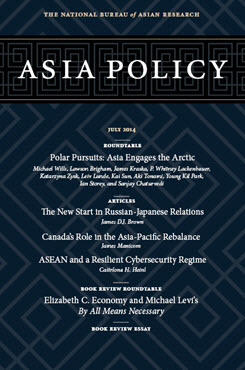Canada and the Asian Observers to the Arctic Council
Anxiety and Opportunity
This essay is part of the roundtable “Polar Pursuits: Asia Engages the Arctic.”
Canada is an Arctic nation, although deep-seated anxieties about sovereignty and control belie its self-proclaimed status as an Arctic superpower. [1] More than 40% of the country’s landmass and 162,000 kilometers (approximately 101,000 miles) of its coastline lie “north of sixty,” spanning approximately one-quarter of the global Arctic. Popular imagery has long cast the Arctic as a resource-rich “frontier of destiny,” a homeland for indigenous peoples, a fragile environment in need of protection, and a source of national inspiration. Through these various lenses, Canadian commentators watch intently as Asian states’ interests grow in Arctic science, environmental issues, resource development, shipping opportunities, and regional governance. For a country with a history of limited investment in northern transportation and economic development, the entrance of new players resurrects old anxieties about national interests, sovereignty, and practical control. While Canada seeks Asian investment to help drive its economic growth, commentators worry about the long-term implications of the rise of Asia, China’s grand strategic interests more generally, and the growing footprint and influence of state-owned enterprises in a sparsely populated region. Accordingly, Canada’s ongoing challenge lies in balancing the emerging opportunities associated with the opening of the Arctic as a resource and transportation frontier with the security and stewardship issues associated with protecting part of the Canadian homeland.
This essay begins with an overview of Canada’s Arctic strategy and how this frames its approach to circumpolar affairs and the Arctic Council, followed by a discussion of Canada’s concerns about the admission of new observers to the council. The next section notes emerging opportunities for enhanced Canada-Asia engagement, despite persistent anxiety about increasing Asian interest in Arctic science, governance, resources, and maritime routes. This essay concludes that by working through existing mechanisms and ensuring that Asian states’ participation does not erode Arctic state sovereignty, Canada and the other Arctic states can realize their national goals, maintain their leadership roles in regional governance, and accommodate growing international interest in the circumpolar north.
Canada’s Arctic Strategy
Canada’s priorities for the Arctic are laid out in its 2009 white paper Canada’s Northern Strategy: Our North, Our Heritage, Our Future, which promotes an overriding agenda of seeking to develop a healthy, prosperous, and secure region within a strong and sovereign Canada. [2] This strategy contains four main pillars: exercising Canada’s Arctic sovereignty, promoting social and economic development, protecting Canada’s environmental heritage, and improving and devolving governance. The Conservative Party government of Stephen Harper considers the sovereignty pillar to be its foremost priority, an approach that capitalizes on Canadian nationalism and primordial anxieties about the country’s control over its share of the Arctic. Despite official assurances that Canadian sovereignty is well established in legal terms and that boundary or status-of-water disputes with neighboring countries are well managed, threat narratives that imagine foreign challenges to Canada’s Arctic lands and seas continue to resonate with Canadians. Nevertheless, the country works closely with other Arctic states to promote and protect its international interests and cooperate on a broader vision for the region.
Official statements confirm that Canada considers the Arctic Council to be the preeminent intergovernmental forum for cooperation between the eight Arctic member states and the international indigenous peoples’ organizations that partake in the council as permanent participants. Among these organizations are the Arctic Athabaskan Council, Gwich’in Council International, and Inuit Circumpolar Council, all of which have Canadian constituents. Canada spearheaded the establishment of the Arctic Council in 1996 and served as its first chair until 1998, thereby forging a special connection with the circumpolar body. [3] In May 2013, Canada began its second term as chair with the overarching theme of “development for the people of the north,” backed by three sub-themes projecting the country’s domestic agenda onto the broader Arctic. The first sub-theme…
Endnotes
[1] See Randy Boswell, “Canada Is ‘Arctic Superpower,’ ” Ottawa Citizen, June 28, 2009.
[2] Government of Canada, Canada’s Northern Strategy: Our North, Our Heritage, Our Future (Ottawa, 2009).
[3] See John English, Ice and Water: Politics, People, and the Arctic Council (Toronto: Penguin Canada/Allen Lane, 2013).
About Asia Policy
Asia Policy is a peer-reviewed scholarly journal presenting policy-relevant academic research on the Asia-Pacific that draws clear and concise conclusions useful to today’s policymakers. Asia Policy is published quarterly in January, April, July, and October and accepts submissions on a rolling basis. Learn more


